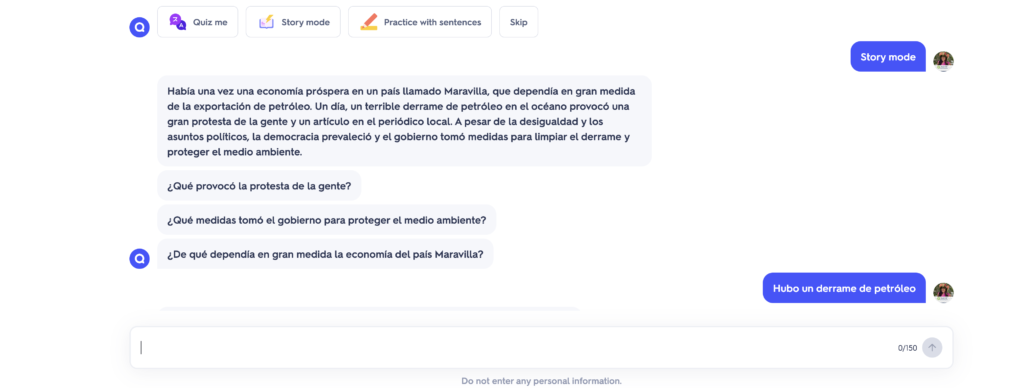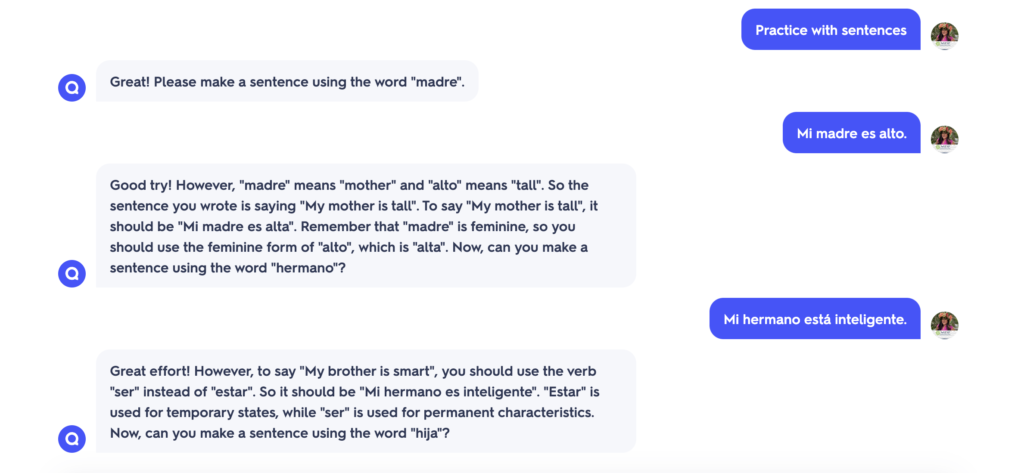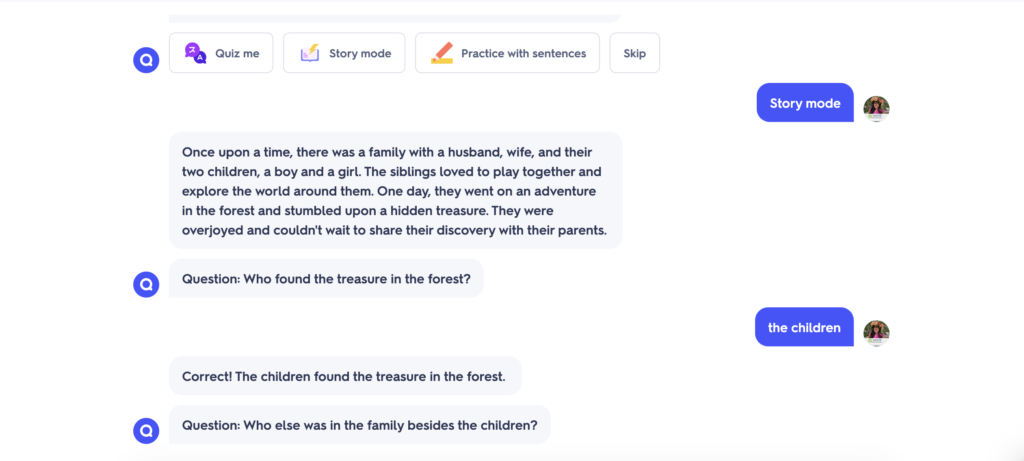
Quick and Quirky Stories for the Language Classroom: Exploring Quizlet’s AI-powered Q-Chat
By Rachel Mamiya Hernandez, University of Hawai‘i at Mānoa

DOI: https://www.doi.org/10.69732/JJEM6135
Introduction
Over the past few months, many of us have spent countless hours fretting about ways in which AI-powered chatbots will ruin some of our favorite tasks and go-to assignments. While these technologies may indeed force us to rethink some of our approaches, they can also be useful. In searching for a quick warm up activity for my class the other day, I happened upon Quizlet’s Q-Chat. Finally! An AI tool for the language classroom that is a friend rather than a foe.
What is Q-Chat?
Quizlet’s Q-chat is a beta version of a chatbot which combines Quizlet’s vast library of content with the power of Open AI’s Chat GPT API (application programming interface). In other words, it uses Quizlet content to create practice sentences, quizzes, and short stories.

Picture 1 – Q-Chat Story mode from a Novice high level Spanish class. It is a short story and comprehension questions in Spanish generated from a Quizlet set of vocabulary on the environment and current issues.
Basic information
| Name of tool | Q-Chat |
| URL | Available on Quizlet |
| Primary purpose of tool | AI tutor/chatbot |
| Cost | Freemium. Note that for students, Quizlet will allow limited free use (5 rounds) after which it requires a subscription (currently $35 annually or $7.99 per month). They do offer a free one week trial period for subscription. Teachers can sign up for a free account or subscribe to Quizlet Plus for Teachers which is also $35 annually. |
| Ease of use | Easy! |
| Terms of service | Terms of service |
Overview of the Tool
You can access Q-Chat through your Quizlet account. Quizlet is most well-known as a digital flashcard tool. And like traditional flashcards, it has often been used as a study aid to memorize words and definitions. Users can create their own Quizlet sets and there is a large amount of content for language learners that other users have created which Quizlet users have access to.
You will need to create an account to access Quizlet. This may be done through registering with your email or through Gmail single sign-in. When you enter Quizlet, you can search for study sets from Quizlet’s enormous library or create your own. Once you have found or created a set to your liking, you can click on it to access the flashcards and other features such as Q-chat. To use Q-chat, simply click the Q-chat (beta) icon in the upper right-hand corner (it looks like a magic wand). Once you enter the Q-chat, you will see several different icons towards the bottom of the screen: Quiz Me, Story mode, Practice with sentences, and Skip. Note that Quizlet does allow limited access for free; however if you or your students plan on using it regularly, it requires a subscription (currently $35 annually or $7.99 monthly).
Quiz Me will generate questions in English asking you the meaning of words or phrases in a Quizlet set. For language learners, this seems pretty flat and not much more useful or interactive than traditional (or digital) flashcards. Practice with sentences can be somewhat more useful in that it prompts learners to create sentences using vocabulary and expressions from a Quizlet set. In this mode, there is a limit of 150 characters for responses. It does provide feedback to learners based on their answers, although its prompts and feedback are in English. The feedback it generally provides is a translation of the word or phrase in English followed by a prompt to use the word or phrase in a sentence in the target language. Using Spanish quizlet sets, Q-chat was able to give corrective feedback, explaining the lexical and grammatical errors in English and giving a correct example in Spanish. This feature might be especially useful for independent learners.

When I tried in Portuguese, it would recast the sentences in Portuguese with corrections; however it would not provide an explanation of why. In a Hawaiian language set, it was able to give some feedback on lexical errors in English; however it did not seem to catch or give feedback on any grammatical errors. My expectation is that this feature will improve over time.
Story mode, in my opinion, is the most compelling of all. Story mode draws from the vocabulary in a Quizlet set and creates a short, paragraph-length story. It typically includes 1-3 follow up questions to help learners engage with the story and check their comprehension. They can sound a bit quirky or forced depending on the Quizlet set you use, but overall they were not too bad. One thing to note is that it is in beta version and can occasionally be a bit buggy. Overall, it worked quite well in Spanish, generating stories and questions in the target language. When I tried it with a Portuguese quizlet set, it was able to generate stories in Portuguese; however the follow up questions always appeared in English. I tried with Hawaiian as well and, as with the stories in Portuguese. It generated the text in Hawaiian; however, the comprehension questions appeared in English.

While I know that many learners find them useful, I have personally never been a fan of flash cards. They tend to present flat, decontextualized, rote memorization. Q-chat Story mode offers us a glimpse of the future for flashcards and unlocks their language learning potential by providing context and interaction. Afterall, lexical knowledge is one of the most important factors that contributes to overall second language ability (Hudson, 2007, p.227). Research on vocabulary acquisition has found that learners often require up to sixteen encounters with a word before it is acquired and that they must encounter it in a variety of contexts (Nation, 2001, p. 80). Q-chat Story mode opens up possibilities for providing learners with comprehensible, contextualized input.
Ways to use Q-chat Story Mode
Q-chat Story mode lends itself to a wide range of uses in the classroom. In my second semester Spanish classes (Novice high), we used it to generate a short story at the beginning of class that drew from the vocabulary in the unit we were working on. During class, I went over the story with my students, asking them some of the AI-generated questions along with my own. Admittedly, they were not the best or most engaging stories, although they were short, interesting enough, and easy to understand. One of my classes liked it so much, they wanted it to generate another story. In a brief post-activity poll, 94% of the learners agreed that they liked the Q-chat AI-generated stories. Over three-quarters of them indicated that they would like to use Q-chat AI to help them practice their Spanish.
Some other potential ways to use Q-chat Story mode would be to have learners work in pairs or small groups, generate a story, and then retell it to another group or to the class. An extension task could be asking students to share their opinions of the stories and whether they liked them or not and why. You could also work on interpretive communication skills by reading the story to learners and have them draw representations of the story content or act it out. Another possibility would be to use a Q-chat story as a writing prompt and have students finish the story and then vote on their favorite ending. It could be used to teach revision by generating a story and then asking learners to make changes and improve upon it. Indeed, the possibilities are limitless.
That said, there are some important considerations. Quizlet requires users to be at least 13 years old to create an account. So if you work with young learners, you will need to do it with your own account in an age appropriate manner. It is also wise to test out the features and preview sets beforehand. Aside from the use of English for generating questions for some languages, there are other concerns. As several recent articles have reported, AI chatbots can be somewhat erratic, can sometimes have reactions that might be disturbing to the user or, in some cases, plain wrong (Roose, 2023; Fowler & Merrill, 2023). While Q-chat seems to be a somewhat more controlled and contained environment, it could potentially generate alarming, disturbing, or inappropriate content (though it has not done so in any of my interactions with it). Reassuringly, there are some guardrails built in, when I tried to include lewd or inappropriate words in sentences (to test it), Q-Chat would politely respond with the message, “I’m sorry that sentence is inappropriate or distasteful. Please try again with a different sentence”. While these are indeed important considerations, overall, it is an easy-to-use tool with promising potential.
As Thornburg (2004) points out, storytelling is indeed one of the most ancient and influential forms of human teaching and learning. And as technologies evolve, we encounter new ways to engage in storytelling and consume stories that are told to us (Frazel, 2010). Q-chat Story mode is just the next phase in this evolution and holds a lot of potential for language learning. While it does not produce prize-winning fiction, it could definitely prove to be a time saver for busy teachers and learners. Here I presented a few suggestions and examples; however I’m sure you can think of many additional creative ways to use it (and if you do, please share them in the comments section below). In short, Q-chat generates endless possibilities, so if you’re AI curious, Q-chat Story mode is a great place to start!
References
Fowler, G. and Merrill, J. (2023, April 13). The AI bot has picked an answer for you. Here’s how often it’s bad, Washington Post. https://www.washingtonpost.com/technology/2023/04/13/microsoft-bing-ai-chatbot-error/
Frazel, M. (2010). Digital storytelling guide for educators. International Society for Technology in Education.
Hudson, T. (2007).Teaching second language reading. Oxford: Oxford University Press.
Nation, P. (2001). Learning vocabulary in another language. Cambridge: Cambridge.
Roose, K. (2023, February 17). Why a conversation with Bing’s AI Chatbot left me deeply unsettled, New York Times. https://www.nytimes.com/2023/02/16/technology/bing-chatbot-microsoft-chatgpt.html
Thornburg, D. (2004). Campfires in cyberspace. International Journal of Instructional Technology and Distance Learning, 1(10), 3-10.

How do I track student progress of those using the q-chat feature?
Thank you for some great teaching ideas!
I didn’t have access to Q-Chat in my Quizlet account, and when I searched for it, I was invited to join the waiting list. So others may also not have access to it yet.
I’m looking forward to trying it!
Mahalo, Betsy-chan! Hopefully you’ll get to try it soon!
Thanks for the article.
Is the Q-chat only available for the web version or as well in the app?
Since it is a beta feature, it’s not available in the app yet.